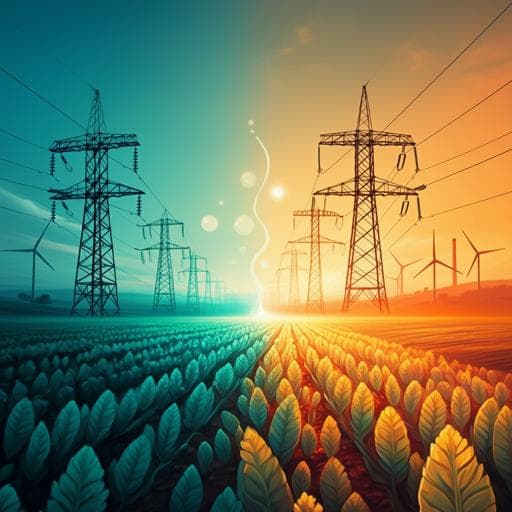
Environmental Studies and Forestry
Greenhouse gas emissions from US irrigation pumping and implications for climate-smart irrigation policy
A. W. Driscoll, R. T. Conant, et al.
This research by Avery W. Driscoll and colleagues reveals that irrigation pump energy use in the US resulted in 12.6 million metric tonnes of CO₂e emissions in 2018. The study highlights the critical factors driving emission variability and emphasizes the importance of integrating GHG emissions considerations into climate-smart irrigation policies.
~3 min • Beginner • English
Introduction
The study addresses a central question for climate-smart agriculture: how large are greenhouse gas emissions from on-farm irrigation pumping across the United States, how are they distributed spatially and across crops, and how might recent climate and energy policies reduce these emissions? Irrigation boosts resilience and productivity under rising heat and precipitation variability but requires energy for water extraction, conveyance, and pressurized application. Emissions from this energy use are usually attributed to the energy sector under IPCC reporting guidelines, obscuring the contribution of specific agricultural practices like irrigation. Prior work has emphasized public water supply or regional irrigation assessments and often lacks spatial detail or comprehensive fuel coverage. This paper provides a national, spatially explicit estimate of irrigation pumping emissions, investigates drivers of variability (water source, groundwater depth, water demand, pump fuel/efficiency, grid intensity), allocates emissions to major irrigated crops, and evaluates implications of US climate policy (notably the Inflation Reduction Act) and pump electrification for future emissions reductions.
Literature Review
The paper situates its contribution within several strands of literature: (1) food system emissions accounting that typically aggregates energy-use emissions within the energy sector and combines agriculture, forestry, and fisheries, limiting practice-level insight; (2) studies of the US water sector’s energy use that largely focus on public water supplies despite irrigation withdrawals being about three times larger; (3) regional or electricity-only assessments of irrigation energy that often use bottom-up engineering approaches (pumping depth, volume, efficiency) and seldom estimate GHG emissions; and (4) evidence of substantial variability in irrigation energy and emissions intensities across geographies and systems. The authors note the need to reconcile top-down (expenditure- and price-based) estimates with bottom-up engineering estimates to improve confidence, and they highlight prior findings on groundwater depth as a key driver, trends in irrigation technology, and nascent adoption of solar-powered pumping.
Methodology
Overview: The study uses a top-down approach to estimate 2018 on-farm irrigation pumping emissions at the state level from fuel expenditures, prices, and emissions factors, then downscales to counties and allocates to major crops. It also projects future emissions under electricity grid decarbonization scenarios with and without pump electrification.
State-level emissions computation: Emissions for each fuel (electricity, natural gas, diesel, gasoline, propane), water source (surface water, groundwater), and state were computed by dividing per-acre fuel expenditures by fuel prices to infer energy consumed, and multiplying by fuel-specific emissions factors. The key equation is: E = (D × A × F) / P, where D is per-acre fuel expenditure, A is irrigated area for that fuel-water-source combination, P is the fuel price, and F is the emissions factor.
Data sources:
- Fuel expenditures and irrigated area by fuel and water source: 2018 USDA Irrigation and Water Management Survey (IWMS). The IWMS provides coefficients of variation used in uncertainty analysis; some values are withheld for confidentiality but represent only ~0.48% of area and ~0.42% of emissions.
- Fuel prices: 2018 US Energy Information Administration (EIA). Diesel and gasoline prices were adjusted to remove on-road taxes to reflect off-road agricultural use; electricity prices used the industrial rate. Only months with average minimum temperature above 0°C were used for electricity and natural gas, reflecting seasonal pump operation; temperatures were derived from PRISM and cropland-weighted.
- Emissions factors: EPA Greenhouse Gas Emissions Factor Hub for stationary combustion (NG, diesel/distillate No. 2, motor gasoline, propane), converted to CO2e using 100-year GWPs for CH4 and N2O. Electricity emissions factors from EPA eGRID (state-level, based on in-state generation).
Uncertainty analysis: A Markov Chain Monte Carlo approach with 10,000 iterations sampled truncated normal distributions (lower bound zero) for IWMS area and expenditure data and EIA fuel prices using reported coefficients of variation and temporal price variability. The 5th and 95th percentiles provided 90% confidence intervals.
County-level downscaling: State emissions were apportioned to counties using county-level volumes of agricultural irrigation withdrawals from USGS (2015), adjusting surface water for 15.9% conveyance losses (USDA 2019). For groundwater, county allocations were scaled by county-to-state ratios of mean water table depth to reflect energy required for lift, using Fan et al. modeled water table depths (1-km, 2004–2014 averages, updated 2020). County emissions equal the sum of surface water emissions (state rate per withdrawal volume × county surface withdrawals) and groundwater emissions (state rate per withdrawal volume × county groundwater withdrawals × depth scaling). Adjustments were made in states where USGS includes golf course irrigation.
Crop-level allocation: For 12 major irrigated crops (corn grain, corn silage, soybeans, wheat, alfalfa hay/haylage, other hay/haylage, rice, cotton, peanuts, dry beans, sorghum grain, vegetables), county emissions were allocated using county emissions rates per volume, crop-specific irrigation application rates, and crop irrigated areas. State-level IWMS application rates were scaled to counties by a regression linking state-level R to precipitation minus reference evapotranspiration (P−ET) computed using FAO Penman–Monteith with PRISM/AgERA meteorology and GMTED2010 elevation, considering months with average minimum temperature above 0°C and cropland weighting. County crop water volumes were reconciled to state totals. Some crops (e.g., irrigated pasture, orchards, barley, sugar beets) were excluded due to data limitations; crops with missing application rate data affected only 0.1% of irrigated area.
Policy scenarios and electrification projections: Future emissions (2022–2050) were projected assuming constant pumping energy demand, using state-level electricity emissions factor trajectories from NREL’s 2022 Standard Scenarios under three cases: Current Policy (including IRA), No IRA, and Tax Credit Extension (continuing PTC/ITC beyond scheduled phase-out). For each, an additional pump electrification pathway was modeled: annual 5% reduction in non-electric pump energy (natural gas, diesel, propane, gasoline) with equivalent service provided by electricity after accounting for motor efficiencies (propane 25%, gasoline 23%, natural gas 21%, diesel 31%, electricity 88%). Electrification reduces total energy demand due to higher efficiency.
Data/code availability: Source data detailed in Supplementary Table S2; generated data in Supplementary Table 3 and Zenodo (doi:10.5281/zenodo.10416689). Code available on Zenodo (doi:10.5281/zenodo.10416689).
Key Findings
- National emissions and energy use: On-farm irrigation pumping produced 12.6 MMT CO2e in 2018 (90% CI: 10.4–15.0), corresponding to ~156 PJ of energy, about 16% of energy-use emissions attributed to the agriculture, forestry, and fisheries sector in the US.
- Water source contributions: Although groundwater comprised 48.5% of withdrawals, it produced 85.0% of emissions (10.73 MMT CO2e; 90% CI: 8.86–12.73). Emissions intensity per volume: groundwater 138 g CO2e m−3 vs surface water 28 g CO2e m−3.
- Fuel mix: Electricity accounted for 68.9% of emissions (8.72 MMT CO2e; 90% CI: 7.16–10.41) and 67.8% of pumped area. Natural gas contributed 19.2% (2.42 MMT; 90% CI: 2.03–2.86) but only 7.5% of area. Diesel covered 22.4% of area but 10.6% of emissions. Propane (1.2% of emissions) and gasoline (0.08%) were minor. After efficiency adjustment, average emissions factor for electric pumps was ~11 g CO2e per MJ, much lower than natural gas (~24 g CO2e per MJ) and other fuels (~23–30 g CO2e per MJ).
- Spatial heterogeneity: Texas, Nebraska, and California together produced 46% of national emissions while holding 39.4% of irrigated cropland. Area-based emissions intensities ranged from 143 kg CO2e ha−1 (Idaho) to 1929 kg CO2e ha−1 (New Mexico), generally higher in arid states (e.g., Texas 1710; Arizona 1576; Oklahoma 1462 kg CO2e ha−1). Emissions were positively associated with irrigated area, water withdrawals, groundwater reliance, and groundwater depth; higher pump fuel efficiency (notably electricity) was associated with lower emissions.
- High Plains Aquifer hotspot: 237 counties over the High Plains Aquifer produced 44.7% of national pumping emissions (5.63 MMT CO2e; 90% CI: 4.82–6.49) with 27.6% of irrigated area. Regional emissions intensity aligned with bottom-up studies (e.g., Kansas High Plains ~231–275 g CO2e m−3). High reliance on groundwater (83.1% of withdrawals) and significant natural gas pump use (72.3% in some states) drove low average pump efficiency.
- Counterexample regions: The Colorado River Basin, despite aridity, had lower emissions intensity (670 vs 1089 kg CO2e ha−1 in High Plains) due to greater surface water reliance (72.4%) and high electrification (87.9% of emissions from electric pumps), with relatively clean grids in parts of the Northwest.
- Crop-specific results: Corn for grain generated the highest total emissions (2.82 MMT CO2e; 90% CI: 2.40–3.30) due to its large irrigated extent (4.8 Mha), though its per-hectare intensity was moderate (585 kg CO2e ha−1; average water use 2653 m3 ha−1). Cotton had the second-highest total emissions with high per-hectare intensity (675 kg CO2e ha−1) reflecting arid, groundwater-reliant regions. Sorghum had very high intensity (970 kg CO2e ha−1) but low total emissions due to small area (0.1 Mha). Soybeans had the lowest intensity (239 kg CO2e ha−1). Alfalfa and other hay together contributed ~1.46 MMT CO2e (90% CI: 1.17–1.77), with emissions concentrated in a few counties (e.g., Imperial County, CA and Maricopa County, AZ accounted for 15% of alfalfa irrigation emissions) but with moderate per-hectare intensities (451 and 380 kg CO2e ha−1).
- Decarbonization potential: Under Current Policy (including IRA), pumping emissions are projected to fall 46% by 2050 relative to 2018, with a minimum around 2038 and slight rebound as tax credits phase down. Extending PTC/ITC yields a 59% reduction; without the IRA, reductions are 39%. Adding pump electrification (5%/year reduction in non-electric energy) reduces 2050 emissions by 70% under Current Policy, and by 86% with tax credit extension. A combined scenario (Current Policy + tax credit extension + electrification) would lower emissions by an additional 5.92 MMT CO2e annually by 2050 versus a no-IRA/no-electrification baseline, to ~1.83 MMT CO2e yr−1. Electrification also cuts pumping energy demand ~29.9% (saving ~46.8 PJ yr−1) due to higher motor efficiency.
Discussion
Findings show irrigation pumping is a material source of agricultural emissions in the US, dominated by groundwater extraction and electricity use, and highly heterogeneous across space and crops. Emissions scale with irrigated extent, water demand, groundwater reliance, groundwater depth, and pump fuel/efficiency, with hotspots over the High Plains Aquifer where deep groundwater and significant non-electric pump use coincide. Regions relying more on surface water, with higher adoption of electric pumps, and cleaner grids (e.g., Northwest, Colorado River Basin) exhibit lower emissions intensities despite high irrigation volumes.
Policy implications are strong: because roughly two-thirds of emissions are from electric pumps, grid decarbonization alone can substantially reduce pumping emissions. The Inflation Reduction Act accelerates reductions; maintaining renewable energy tax credits enhances long-term declines. Full decarbonization, however, requires electrifying non-electric pumps or deploying zero-emission alternatives (e.g., solar), and managing potential rebound effects where improved efficiency lowers pumping costs and may increase water use. The results enable targeted interventions—prioritizing electrification and clean power in high-emission counties, especially over the High Plains; encouraging irrigation expansion (where justified) in lower-intensity regions (shallow water tables, surface water availability, clean grids); and coupling efficiency incentives with safeguards against groundwater overextraction.
The study also underscores that energy-use emissions are only part of irrigation’s GHG footprint. Elevated soil N2O under irrigation, degassing of CO2/N2O from supersaturated groundwater, methane from reservoirs, and off-farm conveyance energy can raise total irrigation-related emissions. Spatial patterns of these sources may compound impacts in arid, groundwater-dependent, and water-importing regions, reinforcing the need for comprehensive accounting to guide climate-smart irrigation policy.
Conclusion
This work provides the first national, spatially explicit estimate of US on-farm irrigation pumping emissions, quantifies drivers of spatial variability, allocates emissions to major irrigated crops, and evaluates how grid decarbonization and pump electrification can reduce future emissions. Key contributions include identifying the dominance of groundwater pumping in emissions, highlighting hotspots over the High Plains Aquifer, and demonstrating substantial reductions achievable through current policy with additional benefits from extending renewable energy tax credits and electrifying pumps.
Climate-smart irrigation policy should jointly weigh the carbon costs of irrigation with water sustainability and adaptation benefits. Lower-emissions expansion is more feasible where groundwater dependence is low, water tables are shallow, supplemental water needs are modest, electric pump adoption is high, and the grid is clean. To approach full decarbonization of pumping, policy should combine continued grid decarbonization with incentives and infrastructure for electric and solar pump adoption, alongside governance to prevent rebound-driven overextraction. Future research should integrate off-farm energy, reservoir CH4, groundwater degassing, and soil N2O into comprehensive irrigation GHG budgets; reconcile top-down and bottom-up energy estimates; refine agricultural user energy prices; and develop scenarios that couple electrification and grid changes with evolving water demand, groundwater levels, and cropping patterns.
Limitations
- Scope limitation: Estimates include only on-farm pumping energy use. They exclude off-farm pumping/conveyance energy, reservoir methane emissions, groundwater CO2/N2O degassing, and irrigation-induced soil N2O increases, so total irrigation-related GHGs are higher than reported.
- Data and method constraints: Top-down approach infers energy from expenditures and prices; survey data (IWMS) are subject to response and reporting errors. Some state data were withheld for confidentiality, though representing small totals (~0.48% area, ~0.42% emissions).
- Fuel price representation: EIA prices may not reflect utility-specific agricultural tariffs; diesel/gasoline adjustments remove road taxes but residual pricing uncertainty remains. Electricity and natural gas prices were seasonally filtered but may still misalign with irrigation-specific tariffs.
- Electricity emissions factors: eGRID uses in-state generation and does not capture interstate electricity transfers; actual emissions intensity faced by some irrigators may differ.
- Downscaling assumptions: County allocations rely on 2015 USGS withdrawals (adjusted for conveyance losses) and groundwater depth data averaged for 2004–2014; temporal mismatches with 2018 activity and local heterogeneity introduce uncertainty.
- Crop allocation: Discrepancies between USDA and USGS irrigation water totals likely bias absolute crop-specific volumes low (though relative shares and spatial patterns are robust). Several irrigated categories (pasture, orchards, barley, sugar beets) were omitted due to data gaps.
- Projections: Future scenarios assume constant pumping energy demand aside from electrification efficiency gains; they do not endogenously model changes in groundwater depth, crop shifts, irrigation extent, climate-driven water demand, or surface vs groundwater reliance. Electrification pathway (5%/yr) is stylized and may not reflect real-world constraints (grid connectivity, capital costs).
Related Publications
Explore these studies to deepen your understanding of the subject.







